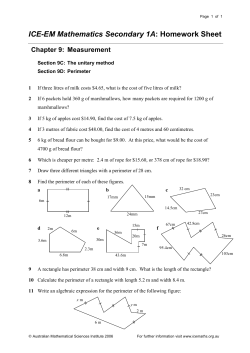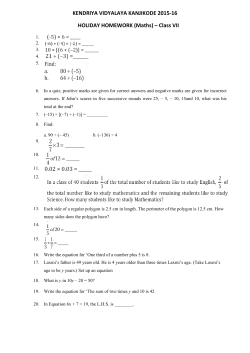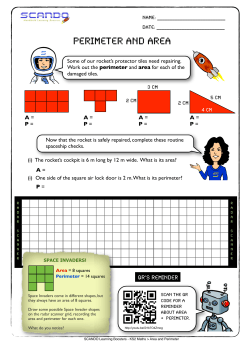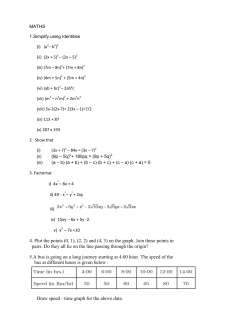
Open-ended problems with purpose
Open-ended problems with purpose May, 2015 Marian Small Agenda • Why open-ended? • What does it mean for problems to have purpose? Start with straightforward ones • Choose two two-digit numbers. • Multiply them. Becomes • You multiply two two-digit numbers and the product has a 5 in the ones place. • What numbers? What product? Becomes • You multiply two two-digit numbers and the product has a 5 in the tens place. • What numbers? What product? You learn • Where values in the product “come from”. • Why it’s so much easier to predict what value will be in the ones place than in the tens place. Or… Who doesn’t belong? • 4 x 15 • 3 x 20 • 4 x 5 x 3 • 4 x 12 You could ask • The area of a rectangle is 30 cm2. • What could the length and width be? Purpose • Understanding the relationship between length, width, and area Or • The number of square centimetres in the area of a rectangle is less than the number of centimetres in the perimeter. • What could the dimensions be? What do you think… • you get out of the last question? Alike and different • How is comparing 4/9 and 3/9 like comparing 9/4 and 9/3? How is it different? What do you think.. the purpose of the last question was? Let’s start with this problem • Build one or more rectangles where the perimeter is three times the length. • What do you notice about the length and width relationship? Possibilities • I’ll choose a length of 4. • The perimeter must be 12. 4 4 Possibilities • The 4 that is left for the 2 widths means each width is 2. 4 2 2 4 Possibilities • I’ll choose a length of 10. • The perimeter must be 30. 10 10 Possibilities • The 10 that is left for the 2 widths means each width is 5. 10 5 5 10 Now you try one • Use a different length– not 4 or 10. • I bet I can predict your width. An alternate approach • If the length is • Then the perimeter is So • Put one stick on top, one on bottom, and split the last stick in half to make the sides. This leads to a much bigger idea-• That WHENEVER there is a relationship between any two of L, W, and P for a rectangle, there is an automatic relationship between any other two. You try • A length is triple the width of a rectangle. • What do you notice about the relationship between perimeter and width? It turns out • • • • If w = 1 and l = 3, then P = 8. If w = 3 and l = 9, then P = 24. If w = 30 and l = 90, then P = 240. Every time: P = 8w (and 8/3 L). I can see that Why open-ended? • To be accessible • To challenge • To evoke rich conversations A problem I tried in Grade 4 Notice • Some properties were easier to use than others (e.g. a very small angle OR angle bigger than a right angle OR symmetry) to make the problem accessible. • There was challenge for kids who wanted to try lots of combinations to see which worked and which didn’t. • Very rich conversation, e.g. We .. • Showed some created shapes and other kids guessed what properties were used. For example • What properties for this one? We .. • Could talk about what combos didn’t work • Could talk about what automatically happened when certain combos were chosen The Big Idea • Certain properties don’t mix (e.g. some, but not all, equal side lengths AND four equal side lengths). • Some properties automatically come together (e.g. 4 equal side lengths and some parallel sides) We tried in Grade 6: Use pattern blocks. 1. Build a design where: • there are three times as many red blocks as yellow ones and • twice as many green blocks as blue ones 2. Tell what fraction of the blocks are each colour. 3/7 1/7 1/7 2/7 red yellow blue green We tried in Grade 6: 3. Add another copy of your design to your first copy. 4. a) Are there still three times as many red blocks as yellow ones? b) Are there still twice as many green blocks as blue ones? c) What fraction of the blocks are each colour now? 3/7 1/7 1/7 2/7 red yellow blue green We tried in Grade 6: Use pattern blocks. 1. Build a design where: • The red area is three times the yellow area • The green area is twice the blue area. 2. Tell what fraction of the area is each colour. 3/5 red 1/5 yellow 2/15 green 1/15 blue We tried in Grade 6: 3. Add another copy of your design to your first copy. 4. a) Is there still three times as much red area as yellow area? b) Is there still twice as much green area as blue area? c) What fraction of the area is each colour now? 3/5 red 1/5 yellow 2/15 green 1/15 blue Did you notice? • Accessible • But challenging • Evoked lots of conversation about the difference between fraction of area and fraction of set, e.g. Is the yellow ½ or 2/3 or both? Probability • • • • You are going to spin a spinner. You are twice as likely to get red as blue. You are half as likely to get blue as green. Draw possible spinners. The point is • The relationship between twice and half. • The assumptions you can make and how they influence your solution. Or this question • Consider numbers that take exactly four words to say (e.g. 4023: four thousand twenty three) • What sort of number can it be? • What sort of number can it not be? What does it do for me? • Students get practice in reading numbers, but… • They gain a better understanding of what 0 as a placeholder means. Number • You model a number with EXACTLY 15 base ten blocks. • What could the numbers be? • What property does the number have to have? Possible numbers • • • • • • 681 555 366 87 1275 1833 • • • • • • 15 24 321 600 330 1500 What the point is • Understanding how the place value system works is why you realize what the digit sums can and cannot be Elapsed time • Three activities take place between 10:30 and 11:30. • Activity 2 is twice as long as Activity 1. • Activity 3 is twice as long as Activity 2. • There are 5 minute breaks between activities. • Write a schedule showing the start and end time for each activity and each break. What happens? • It can be simple for kids if they use 5, 10 and 20 minutes. • It can be challenging for kid figuring out the maximum time lengths possible. • It brings out the point that there is a max time, but not a min time. • It brings out the idea that if you don’t say whether the time is am or pm, there are more options. The game is how to create good open questions • • • • • • • There are strategies you can use: Start with the answer. How are these alike and different? Who doesn’t belong? Choose your own values. Use flexible language. But then you still have to have purpose. So let’s try • Start with a “mundane” question and jazz it up to make it open and have purpose. One example • Continue the pattern for four more terms. 4, 7, 10, 13,… • Could become • The 30th term of a pattern is 91. What could the pattern be? • A pattern is a lot like 4, 7, 10, 13,…. What could it be? • To increase from the 10th term of a pattern to the 20th, you add 30. What could the pattern be? You try • Now you try jazzing up a couple of mundane questions. • But consider purpose. Your questions? In summary • Open questions work so well. • But we don’t use them just to use them. • We use them to make problems accessible to all. • We use them to challenge students who need challenge. • We use them to bring out important mathematical ideas. Download www.onetwoinfinity.ca KatimavikAM
© Copyright 2025









